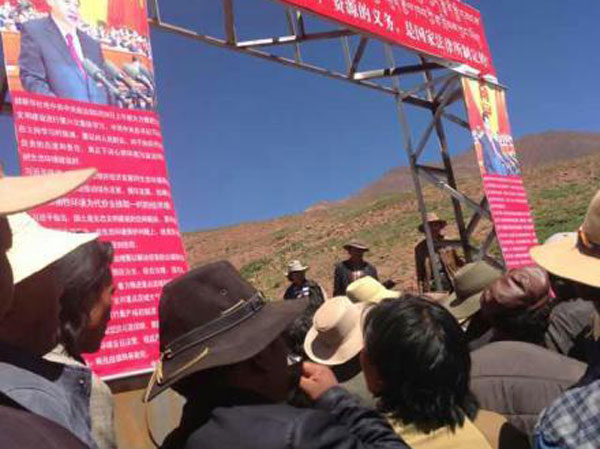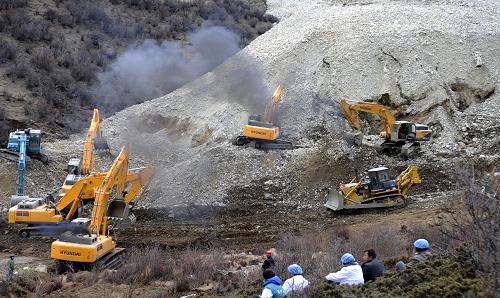The Chinese government recently brought in a new environmental protection law which aims to appease its officials and urban citizens. In a climate of growing public anger due to the toxic smog engulfing Beijing and other Chinese cities, the government swiftly approved the new law and appointed Chen Jining as the minister to enforce it, implying that President Xi Jinping is serious about environmental protection.
But the commercial interests of the giant state-owned companies, which continue to flout environmental laws and still pride themselves as patriots, are deeply intertwined with the wealth of the Chinese central and provincial officials. This means that any decisions that directly affect this lucrative business would mean serious internal friction. There’s also the concern that the new environment law may apply to only China proper rather than extend into the ethnic regions of Inner Mongolia, East Turkestan and Tibet. If this is the case, Chinese companies will have the opportunity to make money far away from Beijing – in places where the laws could be interpreted and manipulated to suit the interests of the officials, or where environment protests are ruthlessly suppressed being deemed “anti-national” or, in the case of Tibet,“influenced by the Dalai clique”.
Over 20 large-scale mining protests in Tibetan areas have been brutally suppressed by the Chinese government in the past five years. The Gyama (near Lhasa) mine landslide in March 2013, which killed 83 mine workers, was clearly induced by mismanagement of the mine but the company was not punished. The following year, the same mine was blamed for the poisoning of a stream flowing through Dokar village but the officials again sided with the mining company.

Mining protesters in Dzatoe county display banners of statement by President Xi Jinping urging protection of the environment, August 2013.
Photo: RFA
In August 2013, the locals of Zatoe in Kham (eastern Tibet) protested against mining in the Sianjainyun Nature Reserve(the source region of the Machu, Drichu and Zachu Rivers). But instead of responding by enforcing the nature reserve protection laws, the officials fired tear gas at the protesters and detained the locals.
The poisoning of rivers due to extensive mining in Tibet now has the potential to go all the way downstream into Asia, threatening the lives of millions of people. Tibet also has huge reserves of lithium, copper, gold and other precious metals and with mining being declared the pillar industry there, this serves as a major threat to the fragile ecosystem of the world’s highest plateau.
There are also claims that Chinese officials have created massive national parks in Tibet. But there are claims that these are all “paper parks” from which Tibetan nomads are being evicted in the name of protecting the environment. Tibetan nomads have historically been the stewards of the vast grasslands of Tibet and over the course of 4,000 years they have developed an ingenious and sustainable culture that works in harmony with the environment, and enabling them to depend on their herds of sheep, goats and especially yaks, which provide everything from milk and cheese to shelter (yak-hair tents), clothing (yak-skin boots) and ropes. In the past, the numbers of these herds were greatly reduced by Chinese settlers and the military, who machine-gunned them for food and for sport.
President Xi Jinping’s commitment to peak carbon emissions by 2030 would mean drastically reducing coal consumption. This commitment is leading to speculation about how Beijing plans to provide for the ever-rising energy need of the world’s second largest economy, with an assumption that it will be met by diverting water from Tibetan rivers to cities and factories in China.
The effects of the 510 megawatt Zammu hydropower dam on YarlungTsangpo in Metok county of Southern Tibet and the 295-metre-high Lianghekou dam on Nyakchu River in the Nyarong area of eastern Tibet are already very apparent. These effects are showing an impact on the region’s wildlife habitats and in reduced river flow into the downstream areas. Of equal concern is Reservoir-Induced Seismic activity (RIS): the earthquakesin Wenchuan in 2008(which killed 80,000 people) and in Ludian last year were induced by the nearby Zipingpu Dam and Xiluodu dam respectively.
How China decides to execute the new law will have lasting impact on Tibet– and it remains to be seen whether there is any scope to implement it for the preservation of Tibet, or whether further mega dams planned on Tibetan rivers, and mining in the mountains, will result in a continuation of the deterioration of the plateau.






 Print
Print Email
Email